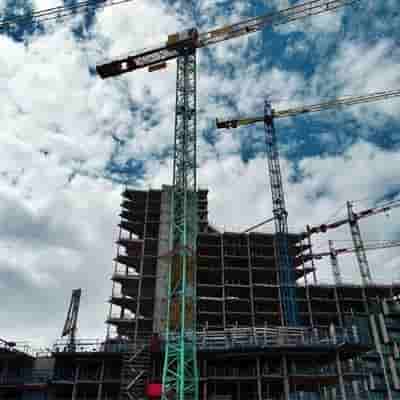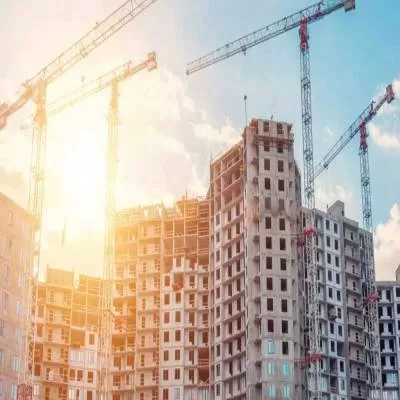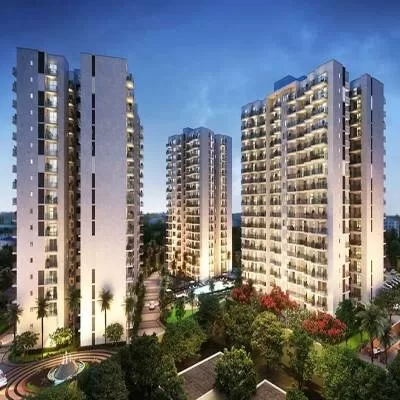- Home
- Real Estate
- Augmenting Affordable Housing

Augmenting Affordable Housing
Affordable housing has been a buzzword in India for decades now - but it has remained thus, just a word. Consequently, owning a decent home is still a distant dream for many lower and even middle-income group families in urban India. As of now, the urban housing shortfall is nearly 20 million, resulting in 15.2 per cent of India´s urban population (about 42.8 million persons) living in slums. With the urban population growing at 2.8 per cent, the need for housing will only increase, further widening the gap between demand and supply. With residential prices skyrocketing year-on-year, over 80 per cent of the homes built by private developers have become unaffordable for middle and lower-income groups.
The reasons behind the grim scenario include lack of suitable policies, lopsided implementation of the schemes that were mooted, a nonconducive regulatory framework, rising land prices, lack of infrastructure where land is relatively cheaper, low access to loans for low-income group buyers, concentration on premium housing by private developers and lack of sustained efforts by the government. ¨There is a huge gap between demand and supply,¨ agrees Sachin Gulaty, Local Director-Strategic Consulting, JLL India. ¨While the supply-side constraints for affordable housing include lack of availability of land and finance at reasonable rates, demand drivers include the growing middle class and urbanisation. Private players have primarily targeted luxury, high-end and the upper-mid housing segment owing to the cost of land and higher returns that can be gained from such projects.¨
Affordability analysis
Interestingly, the very definition of an affordable home is in a state of flux. Affordability being a relative term, what it means and to whom have also undergone changes with different definitions and figures floating around. Worldwide, it has been accepted that affordable housing should address the housing needs of lower or middle-income households and affordability is defined by using three parameters: Income level, size of dwelling unit and price. ¨The term affordable housing generally refers to liveable low-cost housing, especially for the economically weaker section (EWS) and low-income group (LIG) households in India (households with income of less than Rs 2 lakh per annum),¨ elaborates Neeraj Bansal, Head-Real Estate and Partner, KPMG. ¨It is so because the existing housing shortage of almost 2 crore units in urban areas largely pertains to this section. It is estimated that this segment requires a liveable housing unit priced between Rs 3 lakh and Rs 15 lakh (depending upon configuration and size) with size ranging from 30 to 60 sq m, alongwith basic social and physical infrastructure. The requirement is largely concentrated in Tier-I and Tier II cities, and is largely standard across major cities.¨
With no clear-cut definition of the term affordable, affordability as a concept is generic and could have different meanings for people with different income levels, according to Gulaty. ¨Different agencies and countries have defined affordable housing as the economic potential of an individual to buy a house,¨ he says. ¨According to the RBI´s definition provided in July 2014, a house costing Rs 6.5 million and Rs 5 million in the metros and non-metros, respectively, can be qualified as affordable housing. RBI also said that it will periodically review the definition of affordable housing on account of inflation. While most definitions for affordable housing consider area, price and affordability of the occupier, the key idea as per our understanding should deal with the minimum size (volume) of the habitable units, provision of basic amenities, cost and location of the house. Affordable housing is what one can afford, as a measure of expenditure on housing, to income of the household.¨
Apart from the conundrum surrounding the affordability factor, there has been no sustained focus on developing affordable housing from both the states and Centre.
Policy parameters
First, many Indian states do not have an affordable housing policy. Even where there is a policy, it is largely sketchy. No doubt, there have been several adhoc policies and schemes both at the Centre and state levels, like the Urban Land Ceiling Act (ULCA), National Urban Housing and Habitat Policy (NUHHP), Jawaharlal Nehru Urban Renewal Mission (JNNURM), Rajiv Awas Yojana (RAY), slum redevelopment, and other individual state schemes. In addition, state-level housing boards were established to specifically cater to the affordable housing segment. Yet the gap between demand and supply in the affordable segment has only been growing wider. Ineffective implementation and/or loopholes in the policy have been largely cited as the reason by industry pundits.
Ironically, 2.4 lakh houses constructed for the urban poor at Rs 7,000 crore under JNNURM and RAY are lying vacant, the majority of which are in India´s highly urbanised states. The highest unoccupied dwellings are in Maharashtra (53,065) followed by Gujarat (26, 931) and Delhi (26,228). Lack of credit facility for purchasers is cited as a major reason for this. ¨At present, poor households do not have sufficient access to credit,¨ explains Bansal. ¨The credit evaluation process in the Indian financial system is largely document-driven. Most of these households do not have sufficient proof of income, making them ineligible for formal financing. Additionally, most are not aware of any such products.¨
Gulaty concurs, saying, ¨People who belong to the LIG and EWS segments have little access to organised finance. A large percentage of these people are employed in the unorganised sector and often lack proof of address, salary slips, etc. Therefore, they are perceived as a high-risk category and are unable to avail finance for purchase of homes.¨
Such deficiencies are now reportedly being addressed in the new Housing for All by 2022 scheme, launched by the Central Government in June 2015, which has now been rechristened Pradhan Mantri Awas Yojana. ¨This mission envisages enabling and facilitating affordable houses for all in urban cities by 2022. It is estimated that around 2 crore houses will be required to be built by 2022 with an estimated cost of Rs 6 lakh per house. The total amount required is estimated to be around Rs 12 lakh crore,¨ reveals Sanjeev Kumar, former mission director for Housing for All and ex-Joint Secretary Ministry of Housing & Urban Poverty Alleviation. He is currently Managing Director, Maharashtra State Electricity Distribution Co Ltd.
The two major requirements for this mission - land and funds - will be met by acquiring land from various sources and increasing FSI in urban areas. As Kumar shares, ¨Land is envisaged to be made available by converting agricultural land to non-agricultural (NA) land for housing without specific permission from the revenue authority, if the land falls in NA zone in the master plan; by facilitating faster approval of layout and building plan; and making available land under encroachment and owned by various authorities available for urban housing using the PPP mode. Financial resources are expected to be raised primarily by individual beneficiaries assisted by both the Centre and state governments. The Central Government is expected to provide Rs 1.5 lakh per house. The state government and local bodies are expected to contribute significantly and individual beneficiaries are required to raise resources from banks. One of the verticals under the Housing for All mission is a credit-linked scheme, wherein a Government of India subsidy is given as grant to the individual beneficiary by way of interest subsidy if he or she borrows money from a bank or such institutions. Financial resources are required to be raised continuously and other avenues need to be scouted.¨ Obviously, this gigantic mission cannot be fulfilled without active participation from the private sector.
Potential prospects
Global real-estate consultant Cushman & Wakefield estimates a $11.8-billion (Rs 75,800 crore) opportunity for the private sector in the urban affordable housing segment. In a report released in conjunction with CREDAI at NATCON 2015, Cushman pegs the demand for affordable housing at 535,400 units across Delhi-NCR, Mumbai (MMR), Bengaluru, Chennai, Hyderabad, Kolkata and Pune. This is based on demand for units in the price range of Rs 20-50 lakh in these cities, except for Mumbai where the range is between Rs 50-70 lakh.
¨The demand for homes in this sector is driven by the people who need a roof over their heads. Currently, there is a shortage of around 6 crore housing units in this segment presenting a Rs 16-lakh-crore business opportunity to the developer community. Considering the huge potential in this sector, the developer community will rise to meet the challenge and help the government in realising its vision of Housing For All by 2022,¨ assures Hariprakash Pandey, Senior Vice President-Finance, HDIL, which is developing Residency Park in Virar and Paradise City in Palghar and has in the pipeline Planet HDIL in Virar.
The opportunities are tremendous, reiterates Mayur Shah, Member-Governing Council, MCHI-CREDAI. ¨Our estimates reveal that 76 per cent of urban housing needs until 2022 will be concentrated in just 10 states: Uttar Pradesh, Maharashtra, West Bengal, Andhra Pradesh (including Telangana), Tamil Nadu, Bihar, Rajasthan, Madhya Pradesh, Karnataka and Gujarat, contributing a 14.3-million housing, shortage of which the shortage in Maharashtra is estimated at 1.97 million houses. This opens up immense opportunities for developers and has the potential to take the country´s GDP growth into double digits.¨ The MCHI-CREDAI Mumbai chapter and the Maharashtra Government have signed an MoU at the Make in India Summit in February 2016, under which 28 developers have committed to construct 5.69 lakh affordable houses in MMR over the next three years, requiring a mammoth investment of Rs 1.1 trillion.
In July 2015, the Shapoorji Pallonji Group partnered with Standard Chartered Private Equity, IFC, a member of the World Bank Group, and the Asian Development Bank and formed a JV for the development of affordable housing projects across India with a capital commitment of $200 million (equivalent to Rs 1,250 crore). In January this year, the first project under this JV was launched in Howrah. ¨Joyville Howrah is our first project under this partnership for building affordable housing spaces in India,¨ states Venkatesh Gopalkrishnan, Business Head-Joyville Shapoorji. ¨Affordable housing is distinct from the Indian high-end, real-estate market in terms of its market dynamics. We see a huge demand and need across the country for affordable homes. This venture marks the beginning of a journey for the Shapoorji Pallonji Group to realise the dreams of the growing middle-class to own a home. It will also contribute to the Prime Minister´s Housing For All mission of providing 20 million houses by 2020.¨
Private pull
No doubt, the private sector is all set to play a major role in the development of affordable housing. Hitherto, private players shied away from this segment for various reasons including low margins.
¨Under the current housing policy framework and market conditions (land cost, building bylaws, approval costs, limited funding options, construction cost, technology), developing liveable low-cost housing is financially unviable for the private sector,¨ avers Bansal. ¨Hence, low-cost housing projects have not come up in a big way.¨
Shah seconds this, saying, ¨The most important stumbling blocks are scarcity of land and cost of available land. The Government Ready Reckoner Rates only compound the problem. Lack of a unified and effective policy framework for affordable housing, ever increasing construction cost, delays in approvals, manifold increase in government charges and taxes linked to approval of development plans, inadequate long-term funding across the project life-cycle and non-availability of funding for land purchase from banking sources all take away the affordability quotient of any project.¨
Land is the most critical cost in housing projects, points out Gulati. ¨Land cost in urban city centres is high, often constituting over 50 per cent of the project cost for developers, which makes affordable housing projects unviable. Many marketable land parcels in key areas owned by public entities are lying unutilised or underutilised. Even construction costs form a large factor in making projects unviable, as profit margins for the developer increase exponentially compared to construction costs when evaluating projects ranging from the affordable to mid-segment to premium and luxury segments. A control on these costs is also crucial for any housing project to stay affordable.¨
Sriram Mahadevan, Business Head-Happinest, Mahindra Lifespaces, adds his suggestions: ¨Timely, single-window clearance and time-bound, fast-tracked approvals, self-certification, development of ´Affordable Housing Zones´ with enabling zoning conversion provisions, and promotion of innovative construction technology providers co-located with the projects can be a win-win solution. In addition, reduction in stamp duty, exemption from sales tax and a reduction or waiver in registration charges, VAT, etc, which contribute to about 30-35 per cent of home ownership costs should also be considered. Service tax exemption proposal in the recent Union Budget is a good move in this direction that has the potential to reduce the cost of home ownership.¨
Even the present Budget has not addressed many of these issues, aver industry professionals. ¨The tax holiday announced by the government on profits made from affordable housing projects and some service tax exemptions are definitely welcome steps,¨ points out Pandey. ¨But developers are also looking for fast approvals that will improve their margins.¨
According to Rohit Poddar, Managing Director, Poddar Housing, ¨A single-window clearance system is the need of the hour. Additionally, a serious rationalisation of taxes and a clear and transparent Development Control Rule for all of Maharashtra are necessary.¨ He believes the PPP model will work well in this sector if the government can consider contributing land, civic infra such as water and electricity, and speed up approvals. Poddar has developed two projects and three more are under development in and around Mumbai including Poddar Evergreens (Badlapur) and Poddar Navjeevan (Atgaon). Some more are in the pipeline, including Svakam Vihar in Bhivpuri.
¨PPP is a good mechanism and we have witnessed some success stories in the recent past,¨ affirms Bansal. ¨The leading states are Rajasthan and Haryana, which have launched affordable housing projects for EWS and LIG households under PPP. Rajasthan has already delivered more than 2-lakh low-cost houses.¨ PPP is also a major option being considered by the government for the Housing for All mission. To attract private players, the government is planning to introduce several measures, according to Sanjeev Kumar: ¨The measures being pursued by the Ministry of Housing include single-window clearance, deemed NA permission and financial incentives like credit-linked subsidy schemes, developing slum land for housing under PPP, infrastructure status, etc.¨
Peripheral possibilities
Development of peripheral areas is also another suggestion being put forward by industry professionals. ¨With the level of urbanisation being witnessed in the MMR, we need to look at developing peripheral markets,¨ says Shah. ¨The government will have to create both civic and social infrastructure before these locations start finding preference among consumers. Developers are still doing their bit and over 60 per cent of the development that has happened over the past couple of years has been concentrated in peripheral locations.¨
Mahadevan too expresses a similar view: ¨As affordable housing projects would mostly be coming up in peri-urban areas, it is important to focus on last-mile connectivity and infrastructure development. With focused planning and execution of cost-effective connectivity to peri-urban areas, many land parcels available in these areas can then be used for affordable housing.¨ Mahindra Spaces is developing two projects: Happinest Avadi in Chennai and Happinest Boisar near Mumbai. A project in Palghar is also in the pipeline.
Future forward
Evidently, a multi-pronged strategy is necessary to tackle the demand for affordable housing. Augmenting land supply, subsidising land costs, containing costs of construction, use of modern technology, rationalisation of regulations governing the housing sector, and simplification of related rules and procedures, tax and other incentives are the need of the hour.
Quick Bytes
- About 15.2 per cent of the country´s urban population living in slums.
- Requirement is largely concentrated in Tier-I and II cities.
- Two crore houses required to be built by 2022 with an estimated 6 lakh per house.
- $11.8-billion opportunity for the private sector in the urban affordable housing segment.
Affordable Housing - Facts & Figures
- India needs close to 7 million houses every year with 75 per cent of this being in the affordable housing segment.
- Affordable housing demand in India is expected to surge at a CAGR of around 6.1 percent during 2015-2022.
- By 2022 India will need 11 crore housing units.
- About 30-35 per cent of housing cost consist of fees and taxes.
- Uttar Pradesh tops the list in affordable housing shortage with a scarcity of over 3 million urban housing units, followed by Maharashtra (1.9 million units) West Bengal, Andhra Pradesh and Tamil Nadu (fall short by 1.3 million units each).
- In the US and Canada, housing affordability is defined as a housing cost that does not exceed 30 per cent of a household´s gross income.
Sources : Culled from various sources
Highlights of Deepak Parikh Committee Recommendations
A High Level Task Force on affordable housing set up by the Indian Government under the chairmanship of Deepak Parekh, Chairman, Housing Development Finance Corporation Ltd recommended several measures in its reports submitted in 2008. Some of the major recommendations are listed below:
- Place affordable housing at the centre of public policy.
- Bring additional lands into urban usage on a regular basis.
- Simplify procedures of land acquisition and conversion of agricultural land for urban usage.
- Review Master Planning process and make necessary revisions for assessing land requirements and allocating for different uses, including affordable housing.
- Upward revision of FAR and FSI across cities commensurate with investment in infrastructure that it will necessitate.
- Implement in-situ development.
- Revamp State Housing Boards (SHB) and encourage them to play a more active role in affordable housing, even with public-private partnerships.
- Funds raised through land sale transactions by SHBs be ring fenced, with a defined proportion redeployed only for affordable housing.
- Impose a cess of 0.5 per cent on all central taxes to establish a dedicated Shelter Fund with the government providing a budgetary support of equal amount.
- Reinstate income tax deduction under Section 80 IB of the Income Tax Act for developers engaged in affordable housing projects.
- Reduce stamp duty rates and registration fee for affordable housing to 2 per cent ad valorem uniformly in all states
- Set up a housing finance company focusing on micro-finance and upscale-existing micro finance companies.
- Establish real estate regulator, for monitoring and regulating the affordable housing segment.
Deepak Parikh Committee´s definition of affordable housing:
EWS/LIG categories of households
A unit with a carpet area between 300 and 600 sq ft, with (i) the cost not exceeding four times the household gross annual income (ii) EMI/rent not exceeding 30 per cent of the household´s gross monthly income. Household size: Five.
MIG categories of households
A unit with a carpet area not exceeding 1,200 sq ft, with (i) the cost not exceeding five times the household gross annual income. EMI or rent not exceeding 40 per cent of the household´s gross monthly income. Household size: Five members.
- janaki krishnamoorthi
To share your views on the Indian Affordable Housing scenario, write in at feedback@ASAPPmedia.com
- Housing for All
- Sachin Gulaty
- JLL India
- Neeraj Bansal
- KPMG
- Urban Land Ceiling Act
- National Urban Housing and Habitat Policy
- Jawaharlal Nehru Urban Renewal Mission
- Rajiv Awas Yojana
- ULCA
- NUHHP
- JNNURM
- RAY
- LIG
- EWS
- Pradhan Mantri Awas Yojana
- Sanjeev Kumar
- Maharashtra State Electricity Distribution Co Ltd
- Cushman & Wakefield
- CREDAI
- NATCON
- HDIL
- Shapoorji Pallonji Group
- Joyville Ho
With ´Housing for All´ a crying need for the country, and a priority for the government, it is time for a multi-pronged strategy that involves the private sector to bridge the demand-supply gap. Affordable housing has been a buzzword in India for decades now - but it has remained thus, just a word. Consequently, owning a decent home is still a distant dream for many lower and even middle-income group families in urban India. As of now, the urban housing shortfall is nearly 20 million, resulting in 15.2 per cent of India´s urban population (about 42.8 million persons) living in slums. With the urban population growing at 2.8 per cent, the need for housing will only increase, further widening the gap between demand and supply. With residential prices skyrocketing year-on-year, over 80 per cent of the homes built by private developers have become unaffordable for middle and lower-income groups. The reasons behind the grim scenario include lack of suitable policies, lopsided implementation of the schemes that were mooted, a nonconducive regulatory framework, rising land prices, lack of infrastructure where land is relatively cheaper, low access to loans for low-income group buyers, concentration on premium housing by private developers and lack of sustained efforts by the government. ¨There is a huge gap between demand and supply,¨ agrees Sachin Gulaty, Local Director-Strategic Consulting, JLL India. ¨While the supply-side constraints for affordable housing include lack of availability of land and finance at reasonable rates, demand drivers include the growing middle class and urbanisation. Private players have primarily targeted luxury, high-end and the upper-mid housing segment owing to the cost of land and higher returns that can be gained from such projects.¨ Affordability analysis Interestingly, the very definition of an affordable home is in a state of flux. Affordability being a relative term, what it means and to whom have also undergone changes with different definitions and figures floating around. Worldwide, it has been accepted that affordable housing should address the housing needs of lower or middle-income households and affordability is defined by using three parameters: Income level, size of dwelling unit and price. ¨The term affordable housing generally refers to liveable low-cost housing, especially for the economically weaker section (EWS) and low-income group (LIG) households in India (households with income of less than Rs 2 lakh per annum),¨ elaborates Neeraj Bansal, Head-Real Estate and Partner, KPMG. ¨It is so because the existing housing shortage of almost 2 crore units in urban areas largely pertains to this section. It is estimated that this segment requires a liveable housing unit priced between Rs 3 lakh and Rs 15 lakh (depending upon configuration and size) with size ranging from 30 to 60 sq m, alongwith basic social and physical infrastructure. The requirement is largely concentrated in Tier-I and Tier II cities, and is largely standard across major cities.¨ With no clear-cut definition of the term affordable, affordability as a concept is generic and could have different meanings for people with different income levels, according to Gulaty. ¨Different agencies and countries have defined affordable housing as the economic potential of an individual to buy a house,¨ he says. ¨According to the RBI´s definition provided in July 2014, a house costing Rs 6.5 million and Rs 5 million in the metros and non-metros, respectively, can be qualified as affordable housing. RBI also said that it will periodically review the definition of affordable housing on account of inflation. While most definitions for affordable housing consider area, price and affordability of the occupier, the key idea as per our understanding should deal with the minimum size (volume) of the habitable units, provision of basic amenities, cost and location of the house. Affordable housing is what one can afford, as a measure of expenditure on housing, to income of the household.¨ Apart from the conundrum surrounding the affordability factor, there has been no sustained focus on developing affordable housing from both the states and Centre. Policy parameters First, many Indian states do not have an affordable housing policy. Even where there is a policy, it is largely sketchy. No doubt, there have been several adhoc policies and schemes both at the Centre and state levels, like the Urban Land Ceiling Act (ULCA), National Urban Housing and Habitat Policy (NUHHP), Jawaharlal Nehru Urban Renewal Mission (JNNURM), Rajiv Awas Yojana (RAY), slum redevelopment, and other individual state schemes. In addition, state-level housing boards were established to specifically cater to the affordable housing segment. Yet the gap between demand and supply in the affordable segment has only been growing wider. Ineffective implementation and/or loopholes in the policy have been largely cited as the reason by industry pundits. Ironically, 2.4 lakh houses constructed for the urban poor at Rs 7,000 crore under JNNURM and RAY are lying vacant, the majority of which are in India´s highly urbanised states. The highest unoccupied dwellings are in Maharashtra (53,065) followed by Gujarat (26, 931) and Delhi (26,228). Lack of credit facility for purchasers is cited as a major reason for this. ¨At present, poor households do not have sufficient access to credit,¨ explains Bansal. ¨The credit evaluation process in the Indian financial system is largely document-driven. Most of these households do not have sufficient proof of income, making them ineligible for formal financing. Additionally, most are not aware of any such products.¨ Gulaty concurs, saying, ¨People who belong to the LIG and EWS segments have little access to organised finance. A large percentage of these people are employed in the unorganised sector and often lack proof of address, salary slips, etc. Therefore, they are perceived as a high-risk category and are unable to avail finance for purchase of homes.¨ Such deficiencies are now reportedly being addressed in the new Housing for All by 2022 scheme, launched by the Central Government in June 2015, which has now been rechristened Pradhan Mantri Awas Yojana. ¨This mission envisages enabling and facilitating affordable houses for all in urban cities by 2022. It is estimated that around 2 crore houses will be required to be built by 2022 with an estimated cost of Rs 6 lakh per house. The total amount required is estimated to be around Rs 12 lakh crore,¨ reveals Sanjeev Kumar, former mission director for Housing for All and ex-Joint Secretary Ministry of Housing & Urban Poverty Alleviation. He is currently Managing Director, Maharashtra State Electricity Distribution Co Ltd. The two major requirements for this mission - land and funds - will be met by acquiring land from various sources and increasing FSI in urban areas. As Kumar shares, ¨Land is envisaged to be made available by converting agricultural land to non-agricultural (NA) land for housing without specific permission from the revenue authority, if the land falls in NA zone in the master plan; by facilitating faster approval of layout and building plan; and making available land under encroachment and owned by various authorities available for urban housing using the PPP mode. Financial resources are expected to be raised primarily by individual beneficiaries assisted by both the Centre and state governments. The Central Government is expected to provide Rs 1.5 lakh per house. The state government and local bodies are expected to contribute significantly and individual beneficiaries are required to raise resources from banks. One of the verticals under the Housing for All mission is a credit-linked scheme, wherein a Government of India subsidy is given as grant to the individual beneficiary by way of interest subsidy if he or she borrows money from a bank or such institutions. Financial resources are required to be raised continuously and other avenues need to be scouted.¨ Obviously, this gigantic mission cannot be fulfilled without active participation from the private sector. Potential prospects Global real-estate consultant Cushman & Wakefield estimates a $11.8-billion (Rs 75,800 crore) opportunity for the private sector in the urban affordable housing segment. In a report released in conjunction with CREDAI at NATCON 2015, Cushman pegs the demand for affordable housing at 535,400 units across Delhi-NCR, Mumbai (MMR), Bengaluru, Chennai, Hyderabad, Kolkata and Pune. This is based on demand for units in the price range of Rs 20-50 lakh in these cities, except for Mumbai where the range is between Rs 50-70 lakh. ¨The demand for homes in this sector is driven by the people who need a roof over their heads. Currently, there is a shortage of around 6 crore housing units in this segment presenting a Rs 16-lakh-crore business opportunity to the developer community. Considering the huge potential in this sector, the developer community will rise to meet the challenge and help the government in realising its vision of Housing For All by 2022,¨ assures Hariprakash Pandey, Senior Vice President-Finance, HDIL, which is developing Residency Park in Virar and Paradise City in Palghar and has in the pipeline Planet HDIL in Virar. The opportunities are tremendous, reiterates Mayur Shah, Member-Governing Council, MCHI-CREDAI. ¨Our estimates reveal that 76 per cent of urban housing needs until 2022 will be concentrated in just 10 states: Uttar Pradesh, Maharashtra, West Bengal, Andhra Pradesh (including Telangana), Tamil Nadu, Bihar, Rajasthan, Madhya Pradesh, Karnataka and Gujarat, contributing a 14.3-million housing, shortage of which the shortage in Maharashtra is estimated at 1.97 million houses. This opens up immense opportunities for developers and has the potential to take the country´s GDP growth into double digits.¨ The MCHI-CREDAI Mumbai chapter and the Maharashtra Government have signed an MoU at the Make in India Summit in February 2016, under which 28 developers have committed to construct 5.69 lakh affordable houses in MMR over the next three years, requiring a mammoth investment of Rs 1.1 trillion. In July 2015, the Shapoorji Pallonji Group partnered with Standard Chartered Private Equity, IFC, a member of the World Bank Group, and the Asian Development Bank and formed a JV for the development of affordable housing projects across India with a capital commitment of $200 million (equivalent to Rs 1,250 crore). In January this year, the first project under this JV was launched in Howrah. ¨Joyville Howrah is our first project under this partnership for building affordable housing spaces in India,¨ states Venkatesh Gopalkrishnan, Business Head-Joyville Shapoorji. ¨Affordable housing is distinct from the Indian high-end, real-estate market in terms of its market dynamics. We see a huge demand and need across the country for affordable homes. This venture marks the beginning of a journey for the Shapoorji Pallonji Group to realise the dreams of the growing middle-class to own a home. It will also contribute to the Prime Minister´s Housing For All mission of providing 20 million houses by 2020.¨ Private pull No doubt, the private sector is all set to play a major role in the development of affordable housing. Hitherto, private players shied away from this segment for various reasons including low margins. ¨Under the current housing policy framework and market conditions (land cost, building bylaws, approval costs, limited funding options, construction cost, technology), developing liveable low-cost housing is financially unviable for the private sector,¨ avers Bansal. ¨Hence, low-cost housing projects have not come up in a big way.¨ Shah seconds this, saying, ¨The most important stumbling blocks are scarcity of land and cost of available land. The Government Ready Reckoner Rates only compound the problem. Lack of a unified and effective policy framework for affordable housing, ever increasing construction cost, delays in approvals, manifold increase in government charges and taxes linked to approval of development plans, inadequate long-term funding across the project life-cycle and non-availability of funding for land purchase from banking sources all take away the affordability quotient of any project.¨ Land is the most critical cost in housing projects, points out Gulati. ¨Land cost in urban city centres is high, often constituting over 50 per cent of the project cost for developers, which makes affordable housing projects unviable. Many marketable land parcels in key areas owned by public entities are lying unutilised or underutilised. Even construction costs form a large factor in making projects unviable, as profit margins for the developer increase exponentially compared to construction costs when evaluating projects ranging from the affordable to mid-segment to premium and luxury segments. A control on these costs is also crucial for any housing project to stay affordable.¨ Sriram Mahadevan, Business Head-Happinest, Mahindra Lifespaces, adds his suggestions: ¨Timely, single-window clearance and time-bound, fast-tracked approvals, self-certification, development of ´Affordable Housing Zones´ with enabling zoning conversion provisions, and promotion of innovative construction technology providers co-located with the projects can be a win-win solution. In addition, reduction in stamp duty, exemption from sales tax and a reduction or waiver in registration charges, VAT, etc, which contribute to about 30-35 per cent of home ownership costs should also be considered. Service tax exemption proposal in the recent Union Budget is a good move in this direction that has the potential to reduce the cost of home ownership.¨ Even the present Budget has not addressed many of these issues, aver industry professionals. ¨The tax holiday announced by the government on profits made from affordable housing projects and some service tax exemptions are definitely welcome steps,¨ points out Pandey. ¨But developers are also looking for fast approvals that will improve their margins.¨ According to Rohit Poddar, Managing Director, Poddar Housing, ¨A single-window clearance system is the need of the hour. Additionally, a serious rationalisation of taxes and a clear and transparent Development Control Rule for all of Maharashtra are necessary.¨ He believes the PPP model will work well in this sector if the government can consider contributing land, civic infra such as water and electricity, and speed up approvals. Poddar has developed two projects and three more are under development in and around Mumbai including Poddar Evergreens (Badlapur) and Poddar Navjeevan (Atgaon). Some more are in the pipeline, including Svakam Vihar in Bhivpuri. ¨PPP is a good mechanism and we have witnessed some success stories in the recent past,¨ affirms Bansal. ¨The leading states are Rajasthan and Haryana, which have launched affordable housing projects for EWS and LIG households under PPP. Rajasthan has already delivered more than 2-lakh low-cost houses.¨ PPP is also a major option being considered by the government for the Housing for All mission. To attract private players, the government is planning to introduce several measures, according to Sanjeev Kumar: ¨The measures being pursued by the Ministry of Housing include single-window clearance, deemed NA permission and financial incentives like credit-linked subsidy schemes, developing slum land for housing under PPP, infrastructure status, etc.¨ Peripheral possibilities Development of peripheral areas is also another suggestion being put forward by industry professionals. ¨With the level of urbanisation being witnessed in the MMR, we need to look at developing peripheral markets,¨ says Shah. ¨The government will have to create both civic and social infrastructure before these locations start finding preference among consumers. Developers are still doing their bit and over 60 per cent of the development that has happened over the past couple of years has been concentrated in peripheral locations.¨ Mahadevan too expresses a similar view: ¨As affordable housing projects would mostly be coming up in peri-urban areas, it is important to focus on last-mile connectivity and infrastructure development. With focused planning and execution of cost-effective connectivity to peri-urban areas, many land parcels available in these areas can then be used for affordable housing.¨ Mahindra Spaces is developing two projects: Happinest Avadi in Chennai and Happinest Boisar near Mumbai. A project in Palghar is also in the pipeline. Future forward Evidently, a multi-pronged strategy is necessary to tackle the demand for affordable housing. Augmenting land supply, subsidising land costs, containing costs of construction, use of modern technology, rationalisation of regulations governing the housing sector, and simplification of related rules and procedures, tax and other incentives are the need of the hour. Quick Bytes About 15.2 per cent of the country´s urban population living in slums. Requirement is largely concentrated in Tier-I and II cities. Two crore houses required to be built by 2022 with an estimated 6 lakh per house. $11.8-billion opportunity for the private sector in the urban affordable housing segment. Affordable Housing - Facts & Figures India needs close to 7 million houses every year with 75 per cent of this being in the affordable housing segment. Affordable housing demand in India is expected to surge at a CAGR of around 6.1 percent during 2015-2022. By 2022 India will need 11 crore housing units. About 30-35 per cent of housing cost consist of fees and taxes. Uttar Pradesh tops the list in affordable housing shortage with a scarcity of over 3 million urban housing units, followed by Maharashtra (1.9 million units) West Bengal, Andhra Pradesh and Tamil Nadu (fall short by 1.3 million units each). In the US and Canada, housing affordability is defined as a housing cost that does not exceed 30 per cent of a household´s gross income. Sources : Culled from various sources Highlights of Deepak Parikh Committee Recommendations A High Level Task Force on affordable housing set up by the Indian Government under the chairmanship of Deepak Parekh, Chairman, Housing Development Finance Corporation Ltd recommended several measures in its reports submitted in 2008. Some of the major recommendations are listed below: Place affordable housing at the centre of public policy. Bring additional lands into urban usage on a regular basis. Simplify procedures of land acquisition and conversion of agricultural land for urban usage. Review Master Planning process and make necessary revisions for assessing land requirements and allocating for different uses, including affordable housing. Upward revision of FAR and FSI across cities commensurate with investment in infrastructure that it will necessitate. Implement in-situ development. Revamp State Housing Boards (SHB) and encourage them to play a more active role in affordable housing, even with public-private partnerships. Funds raised through land sale transactions by SHBs be ring fenced, with a defined proportion redeployed only for affordable housing. Impose a cess of 0.5 per cent on all central taxes to establish a dedicated Shelter Fund with the government providing a budgetary support of equal amount. Reinstate income tax deduction under Section 80 IB of the Income Tax Act for developers engaged in affordable housing projects. Reduce stamp duty rates and registration fee for affordable housing to 2 per cent ad valorem uniformly in all states Set up a housing finance company focusing on micro-finance and upscale-existing micro finance companies. Establish real estate regulator, for monitoring and regulating the affordable housing segment. Deepak Parikh Committee´s definition of affordable housing: EWS/LIG categories of households A unit with a carpet area between 300 and 600 sq ft, with (i) the cost not exceeding four times the household gross annual income (ii) EMI/rent not exceeding 30 per cent of the household´s gross monthly income. Household size: Five. MIG categories of households A unit with a carpet area not exceeding 1,200 sq ft, with (i) the cost not exceeding five times the household gross annual income. EMI or rent not exceeding 40 per cent of the household´s gross monthly income. Household size: Five members. - janaki krishnamoorthi To share your views on the Indian Affordable Housing scenario, write in at feedback@ASAPPmedia.com
























